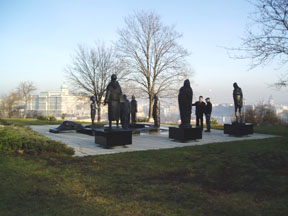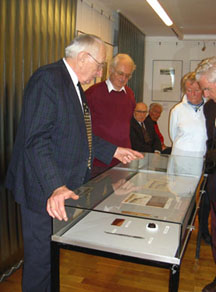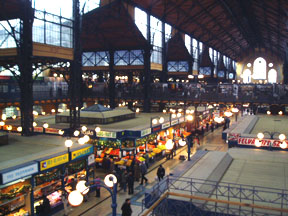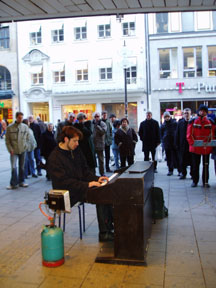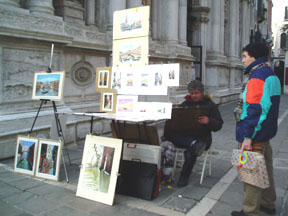See other articles about Travel and Culture
Report from Europe
By CORNELIA SECKEL
ART
TIMES March, 2005
|
|
In
each country
that we traveled — Germany, Austria, Hungary and Italy — we
were surrounded by the history and culture of that country. It is not
that we in the US don’t have a culture, it is just that it is so
much part of our daily lives that it is hard to see the forest for the
trees. We live in such a large area that we don’t see regional differences
until we have traveled hundreds of miles (while in Europe one has already
crossed several other country’s borders). It takes being an outsider
to begin to see the trees and this we were able to do with our friends
and guides as we traveled this past January. We landed in Munich on New
Year’s day, a day that very few people travel, and so the airports
were empty and going through Customs was a breeze. Our first stop was
a short visit just outside of Munich with friends Gabi & Norbert
Wittmer. We went out to dinner and ate at a restaurant typical of
Bavaria. In Europe, as in many other areas of the world, the food and
drink are very much part of the culture. We were in Bavaria and so we
drank wine and beer from the region, ate foods that were specialties of
the restaurant. I was struck by the differences in greetings — in
the Southern part of Germany one says “Praise God” as a morning
greeting, and in the North it is “Good Morning”. Catholicism
permeates Bavaria — although I am not speaking about practicing
Catholics, but the traditional Catholic lifestyle.
After
a few days in Munich, friends Jacky Sparkowsky and Jörg Iwan
from Berlin met us in Regensburg, and we went to Jacky’s
childhood home in Bogen and now a home she has inherited from her
mother. It is certainly a privilege to visit people’s homes when
traveling. For the most part one stays in pensions, hotels, bed &
breakfast inns. Several things struck me in Jacky’s home. The refrigerator
was in a room other than the kitchen (as it was in China), and each room
had a door that could be locked and closed off from the rest of the house
(for conserving heat). In the basement was an old washing tub, under which
a fire could be built. Water
|
|
Jacky
learned that the Annual Christmas Tree Auction was being held at
the Cloister and we thought we would stop in and see what it was all about.
We entered a large room filled with townspeople sitting at row upon row
of tables stretching out at least 100 feet. As we entered, all heads turned
and there was not a sound other than the music of the oompah band in the
far corner. We could almost hear people wondering who these strangers
were. The evening turned out to be delightful. Hundreds of items (sausages,
bottles of beer and pretzels, toys, bottles of liquor and wine, plates
of meats and bread, plants, small decorative items, etc.) were auctioned
off. We were seated at a table next to some young people who were part
of the youth fire brigade (we learned that the auction was a fund raiser
for the firefighters and the oompah band), and all of us began to share
whatever food and drink that we bid on and got during the auction. We
had a very nice time with these young people, some of whom had been exchange
students in the states and eager to practice their English.
Then we were off to Vienna and to Budapest, two cities we had never been to.
Visits
to the Hofburg Palace where I saw rooms from the different reigns
over several hundred years, The Albertina where we hoped to see
some of their drawings and etchings, but were disappointed being told
by the press office that none of the 65,000 drawings and nearly 1 million
prints, including works by Dürer and Klimt, were not on view to the public! What was on view was an exhibition of
Chagall (that I had seen 3 years ago at the Boca Raton Museum
of Art in Florida). None of the permanent collection was on view —
only some reproductions from the collection. It seems absurd to me that
a rotation of their collection was not on exhibit. Meanwhile, any of you
going to Vienna hoping to see these graphics and drawings first-hand will
be disappointed, as we were. We tried to get into the Kunstmuseum (Art
Museum) where 1 of the 3 current Rubens exhibitions was on
view. More trouble, press credentials were not recognized. I had hoped
to speak with the press people, but since they were far away from where
we were, we left. It didn’t seem that Vienna was interested in press
coverage!
|
|
We
made a trip to the Naschmarkt, the city’s largest market
and Saturday flea market (antiques and 2nd hand clothing),
that covered easily 20 city blocks and has at least 4 aisles. I wasn’t
so pleased with the flea market, although there were great buys among the junk, but was thrilled
to see the foods and vegetables, meats and fish. I tasted what I could,
and bought a bottle of honey wine (mead). I headed out to Schloss Schönbrunn,
the former summer residence of the Habsburgs, rulers of Austria from 1273
until 1918. There was quite a bit of history in this Palace with rooms
from different periods, including some tape recordings and readings from
diaries of royal residents. There are extensive gardens and a zoo, best
seen in seasons other than winter. As I entered the first of the series
of rooms, I saw the Children’s Museum with children trying
on clothing, dancing waltzes, drawing and playing with a large model of
the palace.
What was outstanding was a visit to the Spanish Riding School and the stables where the Lipizzaner Horses were kept. In 1562 the horses were brought to Austria from Spain and the school dates back to 1572. We were not able to see a performance by these world-known horses, but did visit the riding hall, the tack room and stables. The steps that the horses follow in the performances come from the battle maneuvers of the Renaissance period. The riders are admitted after rigorous interviewing and only two new riders come to begin their training each year.
I
was moved by the archeological remains of the medieval synagogue in
Vienna and the holocaust memorial on the plaza above. The museum
has a virtual reality video of the development of the synagogue over many
centuries, and while standing on the site of the remains it was very moving
to see the women’s gallery, the place where the Ark stood, and where
the Rabbi led the services.
I
would like to have heard an opera, seen a play at the Burg Theater,
visited the Jewish Museum, gone to a ball and danced waltzes all
night, and seen the holdings of the Albertina. Perhaps on another visit
to Vienna.
While still in New York, I had arranged with the Budapest Tourism Office (I had also contacted the Vienna Tour Office, but got little information from them), and they offered transportation and a guide to give us an overall picture and then make suggestions for us to continue on our own as we were traveling with our friends Jacky and Jörg. Our guide, Richard Bogdán of (Travel Department ), picked us up at our hotel at 9:30 and we were brought to a very comfortable car with Zoltan our driver who made it possible for us to cover a lot of territory in just one day. Richard asked us for any specific needs we had and worked it into his plan. First we got a history lesson and learned about the early settlers in Hungary. There are signs that people were settled in the Budapest area during the Paleolithic Era. Around 100 AD, the Romans established a town that lasted until the 5th Century. There are numerous archeological sites from the Romans: in the Castle District, just out of the city, can be found a museum and the remains of the town of Aquincum, and an amphitheater just outside of the city in Obuda. In 896 a nomadic tribe of Magyars came from the Urals region in Russia and settled in Pannonia. This was the time of the unification of Hungary. After this, came the Mongol Invasion (1241) and they killed off 70% of the population. As a result of this devastation, the Hungarian King invited people from all over to live and repopulate the land – (this is also the time the Jews arrived). Then, the Turks ruled (1526) for 150 years before they were overthrown by the Hapsburg Dynasty. In 1867 the Austro-Hungarian Empire reigned until after WW I, and with their defeat much of the territory was lost. An unfortunate decision to support Germany during the Nazi Regime left Hungary to the Russians after the war. It was in 1989 that the Republic of Hungary proclaimed itself, and the following year free elections took place. For the first time I got a strong understanding and appreciation of the plight of the Hungarian people.
|
|
We
entered the Castle, which was from the 13th Century, through the labyrinth.
The limestone of the hills allowed for many passages under the castle.
Foods and other goods were stored and hidden, secret meetings took place,
and very recently deceased German WW II soldiers were found that were
hiding from the Russians who liberated Budapest from the Nazi soldiers.
Budapest
is also well known for its coffee-houses and their fine cakes and hot
chocolate. We stopped at a small coffee-house (my first and not last),
in which a beautiful large porcelain stove heated the shop. We learned
about Herend Porcelain, the finest porcelain in Hungary, and according
to some, the world, as well as Zsolnay Porcelain which is used
for the tiles on many of the church roofs in the city. As we were walking
along I saw a sign — “Bánsághi Art Studio”
— and told Richard that I wanted to stop in and see if the artist
was available to speak with me. Raymond had seen a drawing that he was
interested in, but the artist was out. We left word with his son who was
watching the shop, asking his father to call us and perhaps meet us at
a nearby restaurant. We went to see the Mátyzás Church,
built between the 13th and 14th Centuries. We then went to the Royal
Palace where we saw the outside of the Hungarian National Gallery,
which houses an extensive collection of Hungarian artists’ work.
(The Museum of Fine Arts has traveling exhibits not necessarily
focusing on Hungarian Artists). The next day we walked across the Danube
via the Chain Bridge (first permanent bridge over the Danube
built in 1839) to visit this museum, and I was particularly moved by the
work of Alajos Stróbel, Miszoly Géza, Ligetti Miklós,
Hollósy Simon, Mihály Munkácsy, and Károly
Lotz. I was sorry we were not able to get any help from the Press
Office at the museum so that Raymond could write about some of these artists.
As journalists, we need to be accurate — and I only hope that is
true for my brief history of Hungary. Also at the Palace we saw the Mátyás
Fountain, walked past Sándor Palace, the home of the
Prime Minister, saw the foundation of a medieval town recently
uncovered just 200 meters from the Prime Minister’s home, passed
the National Dance Theatre, the National Library, the Budapest
History Museum and the Ludwig Museum Budapest – a Museum
of Contemporary Art housing the Ludwig Collection of 150 modern works
donated in 1989 by Peter & Irene Ludwig of Germany and exhibits
of the Social History of Hungary.
|
|
A
sumptuous lunch hosted by the Tourism Office at the Rivalda Cafe &
Restaurant was enlivened by the presence of the artists Tibor Bánsághi
and Maria (whose last name I never got), who had gotten our message and joined us.
We spent quite some time talking about the life of the artist in Budapest.
The story is not any different from other places I have visited. An artist
can either spend his or her time trying to get into commercial galleries
that take 50% commission on any work sold (and more often than not these
are political and social decisions, not decisions of quality of work),
or join organizations with other artists and have exhibitions at public
spaces. Both Tibor and Maria are over 50 and Maria has had a career doing
special effects for films. Tibor came from a family of artists. His grandfather
had an easier time expressing himself in his work. Tibor and his brother,
as well as his father who worked during the time of socialism, had to
deal with much more state control over content. They both expressed concern
at the lack of press that artists get and that it is a hard life, but
as artists there is no choice for them but to do their work and try and
earn a living. This is a familiar sentiment I’ve heard from artists
no matter what country they live in. If they want to be true to their
art they must try and make their own way, a way that doesn’t compromise
who they are and their work. (Before we left the restaurant, Raymond bought
the drawing from Tibor).
When
we left Buda we stopped at the Memorial to the 1956 uprising just outside of the Parliament Building. When I was 10 and in elementary school, I remember
a girl joining our class who had arrived from Hungary, and at that age
I only knew that she had come from another country and had a mystique
about her, which I only now begin to understand. There were several other
sculptures of individuals who had worked and fought for Hungarian Freedom
from foreign regimes. In the Parliament area are numerous historic buildings
(many also built after the unification of Buda and Pest in 1873 and at
the time of the Millennium Celebration of the founding of Hungary.
During this time many other buildings and parks were built in other areas
of Budapest), including The Parliament, The Ministry of Agriculture,
which was the High Court under the Socialist Regime; The
Hungarian Academy of Sciences, The Ethnographical Museum with
a collection of folk costumes representing the various nationalities and
ethnic groups in Hungary, The State Opera House with an exquisite
interior built after the Opera houses in Paris and Vienna and Central
European University. If we had more time in Budapest we would
certainly have visited these places as everywhere we looked was history,
art, and new experiences. We drove past St Stephens, named for
István, the first Hungarian Christian King, which
contains the mummified forearm of King István.
|
|
In the 13th century, Jews were first reported to be in Hungary, the King giving the Jews freedom of religion, a freedom and an integration into the Hungarian society that lasted until 1941, when Nazi anti-Semitic laws were passed. In 1944 deportation of what ultimately came to be up to 600,000 Jews began. It was possible for many Jews to be hidden in Budapest as the deportation began outside the city. Back in 1852 the construction of what is reported to be the largest Synagogue in Europe and 2nd largest in the world began and was built in a Byzantine-Moorish style large enough for 3,000 worshippers. Unfortunately the synagogue and museum was closed while we were there; a small hall is now used for services on Friday and Saturday, as the number of Jewish people in Hungary has diminished. Richard, our guide, was able to be even more thorough as he is Jewish and part of the Jewish community whose attrition rate is escalating. He told us that there were only 15 Rabbis in all of Hungary and 14 were in Budapest. What that meant was there are only a handful of people studying and worshipping, this being a result of 40 years of Socialism and a policy of no religious practices. When recently surveyed, only 300 people identified themselves as Jews although many more than that contributed to the Jewish Charities as part of their income tax returns. What I found particularly interesting was the story of the renovation of this synagogue and the man responsible for it. Many years ago, Emanuel Schwartz left Budapest for New York. He was a very wealthy man and one of the major contributors to Temple Emanu-el, NYC, when the congregation bought property and built a new synagogue on 5th Avenue at 65th Street in NYC. His son, Bernard Schwartz, also a very wealthy man, visited his father’s home in Budapest seeking his roots and learned that the Great Synagogue was is need of restoration and made the largest financial contribution in order to begin the repairs. He was also a major contributor to the sculpture of a weeping willow “tree of life”, a memorial to the Jews killed by the Nazis in WWII. Bernard Schwartz is also known as Tony Curtis, and is a frequent visitor to Budapest.
Before saying goodbye, Richard urged us to go to the National Gallery, to Szentendre (St Andrew) and, if possible, to the Opera House, second best, he said in Europe. He also suggested that we could see the Secession style Buildings which are quite apparent in Budapest in the Gresham Palace, Gellért Hotel and Baths Complex, Sipeky Balázs Villa, Entrance to the Zoo, the main staircase of the Post Office Savings Bank, and the Apartments on Bartók Béla Block.
|
|
Subsequent
days in Budapest found us at an open air market that had a lot of antiques,
porcelain, and flea market items (on route to this market we passed a
large conclave of Chinese Hutons — little living areas similar to
those we saw in Beijing, China — apparently there is a growing Chinese
population); each night we ate at a different restaurant, all of which
had good musicians (Gypsy) playing violins, a base, a cimballom (similar
to a xylophone, except it had strings rather than metal rods) where we
sang, we ate foods with paprika, we drank wines that we had never heard
of. The Coffeehouses were as prolific as in Vienna and we drank coffee,
ate delicious cakes and one place in particular seemed to be not only
a coffee house but also had a gallery space and a room with a stage for
readings and performances. The Central Market was designed by Gustav
Eiffel and is quite a place to visit. My souvenir of choice was little
packets of Paprika as well as hand embroidered boxes (the designs come
from different villages) that I found in this market. I am always interested
to see what fruits, vegetables, parts of animals people eat (heads, feet,
testicles), and this place was fabulous. On the second floor were handmade
items from different ethnic groups in Hungary.
Back
to Munich for a birthday celebration and exhibition, “Die Welt
als Mikrokosmos” (The World in a Microcosm) at the Haus des
Deutschen Ostens, for our friend Heinrich J. Jarczyk. After
the birthday celebration we traveled with Gabi and Norbert Wittmer
to Italy. They have been traveling to Italy for many years, and we were
happy to put ourselves (as we did with Jacky & Jörg) in their
hands.
In
5 hours we passed through incredible differences in landscape: in Austria
we saw the Alps, several ski areas and cross country skiers. Then
into Italy, less snow and deep valleys surrounded by huge mountains that
are stark and steep. We saw the gentle change in the buildings as well
as we left Germany, passed through Austria, and on into Italy. A border
doesn’t change people’s eating and living styles. No wonder
the old allegiances to countries whose territories have been occupied
by various countries over the centuries.
Each
view was more magnificent than the next as we drove through the Alps via
Brenner Pass, and down along the Lake Garda (Lago di Garda),
a beautiful inland lake that is surrounded by high-peaked, snow covered
mountains that in many ways reminded me of Lake Tahoe in Nevada.
We were traveling in the winter and yet it was clear to see what spring
and summer would be like: sailboats, fishermen, outdoor eating, camping
areas, summer homes, and old castles — and lots of tourists. Bardolino
wine comes from this area. (What is also interesting is the attention
paid to what and where wines and beers are produced, and what gets drunk
with what!! This is a focus we rarely come across unless we are dining
with Gourmets). At the southern end of the lake is Sirmione, a
resort town mentioned in history as far back as 56 B.C . People
still come to the area for its hot mineral springs and the peaceful relaxed
atmosphere just as they did in Roman times. We
stayed the night at Hotel Faccioli in Valeggio, a lovely,
small inn built into the walls that surrounded the castle. We walked around
this quaint village that had a mill operating on the Mincio River.
|
|
This was a perfect place to spend two nights as we then had a full day to spend in Verona. There had been two inches of snow the night before (apparently at most, a once-a-year occurrence) and seeing oleander, orange trees and palms with snow on them was a first for me. Our first stop in Verona was the outdoor arena, formerly a Roman Amphitheater for the “entertainment of the citizens.” Now instead of gladiators and lions, each summer there is an Opera Festival with 4 or 5 different operas held over the several months. We walked into the old part of the city and I walked up the Bell Tower (La Torre dei Lamberti first built in 1172), all 365 steps, and was rewarded with a glorious view of Verona. The day was warm and I met up with Gabi, Norbert and Raymond at an outdoor café. We did some window shopping, strolling through the streets of Verona (looking for Two Gentlemen as well as Romeo and Juliet!). In the evening we went to the Opera and saw Ernani by Giuseppe Verdi which was first performed at Teatro la Fenice, Venice in 1844) and written after the play Hernani by Victor Hugo. Going to the opera in Europe is an elegant affair. People take it quite seriously, and any rustling of candy wrappings, clapping at inappropriate times, or coughing is rewarded with an immediate shh!! I enjoyed the production; it was very stylized and highly dramatized with symbolic staging (sets and costumes in a variety of reds). The Theater was beautiful — huge chandeliers, boxes, balconies with only one row of seating, others with easy chairs.
As closed in as the streets and alleyways are, there is still an expansive feeling — perhaps it is the waterways that are never-ending. This has been a gateway between East and West and a center for culture for centuries. As if on a planned schedule, we arrived at the top of the Rialto Bridge just in time to view a glorious sunset. We left Venice after a full day of exploring and I thought, this is not the last time I will visit this city. Perhaps spending a few weeks would really allow me to know some of its treasures.
|
|
From
Munich, we went to visit Heinz and Christiane Jarczyk in
Cologne for some quiet time to begin digesting all the images and
ideas we took in over the past weeks before heading back to New York.
Now
this next part in particular is what made family and friends hard to be
sympathetic about all the work facing us in the office on our return.
After an overnight in Queens, we left for Barbados staying with Barbara Gill, owner of Valley Courier in Kingston, NY (they’ll
travel anywhere you need them to go) for 8 days of rest and relaxation
(although I did write most of this report there) and some time visiting
a few artists and galleries.
Traveling
is a wonderful way to come out of my own world — as open as I think
it is. I am now much more ready to read and understand history, to see
that the problems people have with one another today goes back hundreds
of years to political maneuvers that changed peoples lives. Understanding
the bigger picture is deepening, rewarding and humbling.


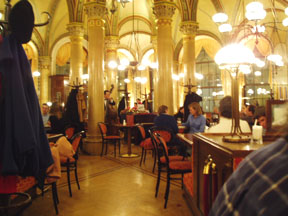
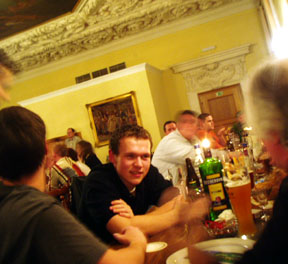 "Christmas
Tree Auction" at the Cloister in Bogen,
"Christmas
Tree Auction" at the Cloister in Bogen, 